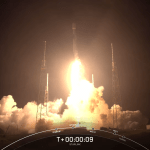Dominique Luchart's Blog, page 639
April 29, 2021
PS5 preorders begin in China, almost six months after US launch, Jon Porter

 Photo by Vjeran Pavic / The Verge
Photo by Vjeran Pavic / The VergeThe PS5 will be available to buy in China on May 15th, a little over six months after its original release in the US last year, Sony announced today. The disc version of the console will retail for 3,899 yuan (around $600), while the cheaper disc-free model will cost 3,099 yuan (around $479). Preorders open today. The launch means Sony’s next-gen console will beat Microsoft’s to release in the country, although CBNC notes that Microsoft received safety approvals to release the Xbox Series X and Series S there at the end of last year.
Relative to its size and population, China isn’t considered a huge market for console gaming. Game consoles were technically illegal in the country until 2014, which meant PC and mobile gaming has become…
The post PS5 preorders begin in China, almost six months after US launch, Jon Porter appeared first on NEWDAWN Blog.
PS5 preorders begin in China, almost six months after US launch,

The PS5 will be available to buy in China on May 15th, a little over six months after its original release in the US last year, Sony announced today. The disc version of the console will retail for 3,899 yuan (around $600), while the cheaper disc-free model will cost 3,099 yuan (around $479). Preorders open today. The launch means Sony’s next-gen console will beat Microsoft’s to release in the country, although CBNC notes that Microsoft received safety approvals to release the Xbox Series X and Series S there at the end of last year.
Relative to its size and population, China isn’t considered a huge market for console gaming. Game consoles were technically illegal in the country until 2014, which meant PC and mobile gaming has become dominant. Even now, strict laws make it hard to release consoles in China simultaneously with other countries. The PS4, Xbox One, and Switch have all released in China, with Nintendo’s console reportedly being the most successful.
The PS5’s Chinese launch comes as the console faces stock issues around the world. A combination of unexpectedly high demand as well as supply chain issues including a global chip shortage, have been blamed for the problems. However, Sony Interactive Entertainment president and CEO Jim Ryan recently said he expects the stock situation to improve in the second half of the year.
The post PS5 preorders begin in China, almost six months after US launch, appeared first on NEWDAWN Blog.
Vivaldi is updating its browsers to block annoying cookie pop-ups, Ian Carlos Campbell

 Image: Vivaldi
Image: VivaldiVivaldi announced today that it’s updating the desktop and Android versions of its Vivaldi browser with the ability to block annoying cookie preference pop-ups. Thanks to the passage of the European Union’s General Data Protection Regulation (GDPR), you’ve probably had to click through at least one dialog box asking if you’d like to manage how a site tracks you. Vivaldi’s new update lets you avoid those notifications — with some major caveats — while theoretically still keeping you safe from tracking.
Vivaldi’s logic for the new feature, affectionately called “Cookie Crumbler,” is that while giving users control over how they’re tracked is good, doing so through a pop-up “leads to clicking ‘allow’ or ‘accept’ without realizing that…
The post Vivaldi is updating its browsers to block annoying cookie pop-ups, Ian Carlos Campbell appeared first on NEWDAWN Blog.
Vivaldi is updating its browsers to block annoying cookie pop-ups,

Vivaldi announced today that it’s updating the desktop and Android versions of its Vivaldi browser with the ability to block annoying cookie preference pop-ups. Thanks to the passage of the European Union’s General Data Protection Regulation (GDPR), you’ve probably had to click through at least one dialog box asking if you’d like to manage how a site tracks you. Vivaldi’s new update lets you avoid those notifications — with some major caveats — while theoretically still keeping you safe from tracking.
Vivaldi’s logic for the new feature, affectionately called “Cookie Crumbler,” is that while giving users control over how they’re tracked is good, doing so through a pop-up “leads to clicking ‘allow’ or ‘accept’ without realizing that unwittingly users just gave permission for trackers to create behavioral profiles about them,” Vivaldi writes.
 A cookie dialog box from The Guardian.
A cookie dialog box from The Guardian.Vivaldi’s built-in Ad Blocker can theoretically already handle hiding users from the various tracking methods deployed by sites, so Cookie Crumbler is about removing the annoying hangers-on — the pop-up notifications that direct users to customize how they’re tracked, if at all. Users with an updated version of Vivaldi (version 3.8 as of today) can enable Cookie Crumbler by going to Settings > Privacy > Tracker and ad blocking > Manage sources > Remove cookie warnings lists. The same feature can be enabled on the Android version of Vivaldi under the same menus.
 “Cookie Crumbler” can be enabled on Android in the same menu you manage Vivaldi’s ad and tracker blocker.Image: Vivaldi
“Cookie Crumbler” can be enabled on Android in the same menu you manage Vivaldi’s ad and tracker blocker.Image: VivaldiCookie Crumbler pulls from two separate third-party block lists to work, but “this is not a perfect solution, as there will be a few websites that use other tactics to obtain cookie consent,” Vivaldi says. Enabling Cookie Crumbler may also make some sites completely inaccessible on desktop and mobile, depending on if the site locks some functionality behind interacting with the cookie dialog. Losing access to some websites is a major inconvenience for a web browser that’s designed to visit websites, and that may be why Cookie Crumbler isn’t enabled by default.
Vivaldi is also taking an even stronger stance on Google’s cookie alternative, FLoC, or Federated Learning of Cohorts. FLoC builds cohorts from users’ browsing history to sort them semi-anonymously by interests or qualities for websites looking to sell ads. It seems less directly invasive than a traditional cookie, but also hugely dependent on browser makers implementing it correctly for it to be safe.
Vivaldi is decidedly not okay with Google’s implementation of FLoC and is not enabling it in its browser, despite relying on Google’s Chromium codebase. With today’s updated version of Vivaldi, it’s also blacklisting the FLoC component required for Google’s current test of the ad technology, removing it from browsers that might already have it downloaded and preventing it from being downloaded going forward.
Vivaldi 3.8 also adds new customization options for the browser’s Panels feature (think SlideOver in iPadOS but for websites) and a new keyboard command for adding bookmarks. The Android version of the app can also now switch between the 41 languages Vivaldi supports rather than relying on Android’s built-in language settings.
The post Vivaldi is updating its browsers to block annoying cookie pop-ups, appeared first on NEWDAWN Blog.
April 28, 2021
Would you pay $30 a month for a faster web browser that eats less battery?,

No matter how much web browsers improve, it feels like they can’t keep pace with everything we want to do. Open one too many tabs on a few-year-old laptop, and your fan starts spinning, your battery life dips, your system starts to slow. A faster or cleaner PC might fix it, but a startup called Mighty has a different idea: a $30-a-month web browser that lives in the cloud.
Instead of your own physical computer interacting with each website, you stream a remote web browser instead, one that lives on a powerful computer many miles away with its own 1,000Mbps connection to the internet.
Suddenly, your decent internet connection would feel like one of the fastest internet connections in the world, with websites loading nigh-instantly and intensive web apps running smoothly without monopolizing your RAM, CPU, GPU and battery, no matter how many tabs you’ve got open — because the only thing your computer is doing is effectively streaming a video of that remote computer (much like Netflix, YouTube, Google Stadia, etc.) while sending your keyboard and mouse commands to the cloud.
[embedded content]Skeptical? I definitely am, but perhaps not for the reason you’d think — because I tried this exact idea nearly a decade ago, and it absolutely works in practice. In 2012, cloud gaming pioneer OnLive introduced a virtual desktop web browser that would let you load full websites on an iPad in the blink of an eye and stream 4K video from YouTube. (Quite the feat in 2012!) I called it the fastest web browser you’ve ever used, and OnLive’s asking price was just $5 a month.
Cloud desktop providers like Shadow have also offered similar capabilities; when you rent their gaming-PCs-in-the-cloud ($12-15 a month), you can use those virtual PCs’ built-in web browsers to get similar speeds, thanks to the fact they typically live in data centers with very few hops to (and possibly direct peering arrangements with) major content delivery networks.
Mighty argues that by focusing on the browser (rather than recreating a whole Windows PC), it can give more people what they actually want. “Most people want an experience where the underlying OS and the application (the browser) interoperate seamlessly versus having to tame two desktop experiences,” founder Suhail Doshi commented at Hacker News. Mighty claims it’ll eliminate distracting cookies and ads, automatically notify you about Zoom meetings, quick search Google Docs and presumably other integrations to come. Mighty also says it encrypts your data and keystrokes, among other security promises.
But it’s not entirely clear why it costs so much more, or who would be willing to pay $30 a month for such a subscription — you’d think the kinds of people who can afford a monthly browser bill on top of their monthly internet bill would be the same kinds of people who can afford a faster PC and faster internet to begin with. Gigabit fiber is already a reality for some homes, and it’s not like Mighty will turn your iffy 25/3 connection into a gigabit one; while Doshi tells me it’ll technically work with a 20Mbps connection, he says he’s targeting 80+Mbps households right now.
Then again, it’s not like everyone has a real choice of internet service provider, no matter how much money they make. As Jurgen Geuter (aka tante) points out below, this feels more like an indictment than innovation. It’s been a decade, and we still haven’t solved these problems.
“Streaming your browser to you because rendering the HTML is too slow on your machine” is not innovation but a mark of shame on everyone building websites and browsers.
Tech failed as an industry. https://t.co/JJC0WomArb
— tante (@tante)
I agree with my colleague Tom: I genuinely want to know who’d actually pay for this and why. Would you?
I want to meet whoever is going to spend $30 a month to stream a Chromium browser from the cloud just to avoid RAM hungry Chrome https://t.co/4pl6jL2zUV
— Tom Warren (@tomwarren)
The post Would you pay $30 a month for a faster web browser that eats less battery?, appeared first on NEWDAWN Blog.
Would you pay $30 a month for a faster web browser that eats less battery?, Sean Hollister


No matter how much web browsers improve, it feels like they can’t keep pace with everything we want to do. Open one too many tabs on a few-year-old laptop, and your fan starts spinning, your battery life dips, your system starts to slow. A faster or cleaner PC might fix it, but a startup called Mighty has a different idea: a $30-a-month web browser that lives in the cloud.
Instead of your own physical computer interacting with each website, you stream a remote web browser instead, one that lives on a powerful computer many miles away with its own 1,000Mbps connection to the internet.
Suddenly, your decent internet connection would feel like one of the fastest internet connections in the world, with websites loading nigh-instantly and…
The post Would you pay $30 a month for a faster web browser that eats less battery?, Sean Hollister appeared first on NEWDAWN Blog.
SpaceX rocket launches another 60 Starlink satellites, nails its 7th landing at sea, ,

CAPE CANAVERAL, Fla. — A SpaceX Falcon 9 rocket launched a new batch of 60 Starlink internet satellites into orbit on Wednesday evening (April 28) and nailed a landing at sea to top off a successful mission.
The veteran Falcon 9 rocket blasted off from Space Launch Complex 40 here at Cape Canaveral Space Force Station in Florida at 11:44 p.m. EDT (0344 April 29 GMT), marking the company’s 10th launch of the year.
“The Falcon 9 first stage has landed for its seventh time,” SpaceX engineer Jessie Anderson said during the launch broadcast. “This marks our 81st recovery of an orbital class rocket.”
Approximately nine minutes later, the rocket’s first stage returned to Earth, touching down on SpaceX’s drone ship “Just Read the Instructions,” for its seventh successful landing.
Video:
SpaceX launches Starlink 24 mission! Nails booster landing at sea
Related:
SpaceX’s Starlink satellite megaconstellation launches in photos
[image error]
A SpaceX Falcon 9 rocket launches on the Starlink 24 mission, on April 28, 2021, at 11:44 p.m. EDT (0344 April 29 GMT). (Image credit: SpaceX)The launch marked the third of the evening, as Arianespace launched a Vega rocket from Kourou, French Guiana roughly two hours earlier, at 9:50 p.m. EDT (0150 GMT on April 29). China then launched the core module of its next space station at 11:23 p.m. EST (0323 GMT on April 29), followed by SpaceX.
SpaceX is continuing the rapid launch pace set last year, as the Hawthorne, California-based rocket builder celebrated its 12th launch so far in 2021. The majority of those launches have been SpaceX’s own Starlink satellites, as the company surpasses its initial internet constellation of 1,440 broadband satellites.
That constellation could eventually be tens of thousands of satellites strong as SpaceX has permission to launch as many as 30,000, with an option for even more.
Forecasters at the 45th Space Wing’s Weather Squadron predicted favorable conditions at launch and the weather did not disappoint.
[image error]
The Falcon 9 booster stuck a landing on the drone ship “Just Read the Instructions.” (Image credit: SpaceX)Rapid reuseThe booster for Wednesday’s launch, called B1060, is one of SpaceX’s fleet of flight-proven boosters. The veteran flier now has seven launches and landings under its belt as the company has plans to push its Falcon 9 rockets to the limit.
B1060 made its debut in June 2020, when it carried an upgraded GPS III satellite into space for the U.S. Space Force. That mission was the first time that the military gave SpaceX the green light to go ahead and recover the booster. (Previously, all military missions flew on expendable rockets.)
Once the booster returned to Port, it was prepared for its next mission: to carry a stack of Starlink internet satellites into space. Following back-to-back Starlink missions, the veteran booster then carried a communications satellite into space for Turkey.
Its subsequent missions have all contained Starlink payloads. Wednesday’s flight marks the fifth load of the broadband satellites that this particular booster has carried into space. SpaceX has been using its previously flown boosters with the most miles to transport its own satellites into space.
[image error]
The 60 Starlink satellites launched on SpaceX’s Starlink 24 mission deployed successfully about an hour after liftoff. (Image credit: SpaceX)This is the 115th overall flight for Falcon 9, and the 61st flight of a used, refurbished booster. In fact, every single SpaceX launch so far in 2021 has been on a flight-proven rocket.
When the upgraded Falcon 9 debuted in 2018, SpaceX Founder and CEO Elon Musk told reporters that the company expected each Falcon 9 to fly 10 times with few refurbishments in between flights, and as many as 100 times before retirement.
The company has learned a lot through the refurbishment process, and according to Musk, there doesn’t seem to be a hard limit on the number of flights that any given Falcon 9 can fly.
“You probably don’t want to be on a life leader for a crewed mission, but it’s probably good to have a flight or two under its belt, for the booster to have flown once or twice,” he said during a post-launch media call after the Crew-2 astronaut mission to the space station. “If it was an aircraft coming out of the factory, you’d want the aircraft to probably have gone through a test flight or two before you put passengers on.”
“So I think that’s probably a couple of flights is a good number for a crew booster, and in the meantime, we’ll keep flying the life leader,” Musk said. “We’ve got nine flights on one of the boosters. We’re going to have a 10th flight soon with a Starlink mission.”
Musk did indicate that the company would push the Falcons to the limit and keep flying them on Starlink missions until they break, which could well surpass the 10 flights previously predicted.
Having a fleet of flight-proven rockets at its disposal allows SpaceX to keep up with its rapid launch cadence. However, company officials have stressed that while losing a booster is unfortunate, the main objective of each mission is always to deliver the payload safely to its intended orbit. Anything beyond that is a bonus.
Constellation expansionWith Wednesday’s launch success, SpaceX has launched more than 1,500 Starlink satellites into orbit, which includes some that are no longer operational. This goes beyond the company’s initial quota, but there are many more launches coming as the company has sought approval for tens of thousands more.
SpaceX launched its massive internet constellation, to help provide internet coverage to the world, in particular those in remote and rural areas. To that end, company engineers designed a fleet of flat-paneled broadband satellites to fly over the Earth, beaming down internet coverage to users who can access the service via a compact user terminal.
Currently Starlink is still in its beta-testing phase with users in the U.S., Canada, the U.K., Germany and New Zealand able to access the service. The company is currently taking preorders for the internet service but is planning for a full rollout later this year. Prospective users can go to the company’s website and reserve the service with a $99 deposit right now.
Starlink review: How good is Elon Musk’s satellite internet service?
SpaceX is not the only company with aspirations of connecting the globe. OneWeb, Amazon and Telstar all have constellations of their own planned. However, OneWeb is currently the only other service with actual satellites in space.
The London-based company launched 36 of its satellites last month on a Russian Soyuz as it works to fill out its planned constellation containing 650 satellites. (To date, OneWeb has launched five of its planned 19 missions.)
There was a minor kerfuffle between SpaceX and OneWeb this month as OneWeb reported that one of its satellites had a ‘close call’ with one of SpaceX’s Starlink satellites. More recent filings with the Federal Communications Commission (FCC) have shed some light on the incident, showing that there was no potential collision and that the situation was exaggerated.
SpaceX recently inked a deal with NASA to steer its satellites out of the way if there was any sort of close call with any one of the agency’s satellites or the International Space Station. That only pertains to NASA though; currently there’s no global or national regulation that would mandate one company to move its satellites out of the way of another entity.
In 2020, the space station had to adjust its orbit a number of times to avoid potential collisions with objects in orbit. So the creation of this Space Act Agreement with SpaceX is a huge step towards mitigating potential collisions.
Fairing recovery[image error]
The net-equipped SpaceX boat GO Ms. Tree catches a Falcon 9 payload fairing half on Aug. 18, 2020. (Image credit: Elon Musk via Twitter)Both of the fairing halves featured in Wednesday’s mission are brand new, and with any luck, they will fly again soon.
That is, if they land intact. Thanks to onboard parachutes and navigation software, the clamshell-like hardware will glide itself back to Earth and gently splash down in the Atlantic Ocean. From there, the two fairing pieces will be pulled from the water by SpaceX’s newest boat, a bright pink and blue vessel named Shelia Bordelon.
This is the third mission now for Shelia Bordelon, which uses an onboard crane to retrieve the fairings.
Follow Amy Thompson on Twitter @astrogingersnap. Follow us on Twitter @Spacedotcom or Facebook.
The post SpaceX rocket launches another 60 Starlink satellites, nails its 7th landing at sea, , appeared first on NEWDAWN Blog.
April 27, 2021
On This Day in Space! April 27, 1961: NASA launches Explorer 11, ,

On April 27, 1961, NASA launched Explorer 11, a satellite that contained the first gamma ray telescope to go to space. This marked the birth of space-based gamma ray astronomy.
Gamma rays are a form of electromagnetic radiation and have the highest energy of any kind of wave in the electromagnetic spectrum. These waves come from things like supernova explosions, supermassive black holes, and even solar flares.
[image error]
An artist’s illustration of NASA’s Explorer 11, which launched on April 27, 1961. (Image credit: NASA)Before Explorer 11 launched to look for gamma rays in space, scientists were pretty sure that gamma rays were out there. However, they had to way of detecting these gamma rays, because they get absorbed in Earth’s atmosphere.
Explorer 11 detected 22 cosmic gamma rays during its seven-month mission. These rays were coming from all over the place and didn’t seem to point to any particular sources out in space. This observation became the first evidence of a uniform gamma-ray background in the universe.
Catch up on our entire “On This Day In Space” series on YouTube with this playlist.
[image error]
History of NASA: $22.99 at Magazines Direct
Discover the story of how and why NASA was created, its greatest triumphs, darkest days, and of the times it exceeded all possible hopes. A tale of adventure, heroism and resourcefulness, learn of the space agency’s greatest achievements and how — over six decades — the organization has consistently and tirelessly devoted itself to its founding principle: that “activities in space should be devoted to peaceful purposes for the benefit of all humankind”. View Deal
Still not enough space? Don’t forget to check out our Space Image of the Day, and on the weekends our Best Space Photos and Top Space News Stories of the week.
Email Hanneke Weitering at hweitering@space.com or follow her @hannekescience. Follow us @Spacedotcom and on Facebook.
Join our Space Forums to keep talking space on the latest missions, night sky and more! And if you have a news tip, correction or comment, let us know at: community@space.com.
The post On This Day in Space! April 27, 1961: NASA launches Explorer 11, , appeared first on NEWDAWN Blog.
Microsoft Teams is down worldwide, Tom Warren


Microsoft Teams is down and experiencing an outage worldwide. The issues started at around 6:30AM this morning, and are blocking connectivity for many Microsoft Teams users across Europe and Asia. Microsoft is aware of the issues and is currently investigating the route cause.
“We’ve confirmed that this issue affects users globally,” says Microsoft’s 365 status account on Twitter. “We’re reviewing monitoring telemetry and recent changes to isolate the source of the issue.”
Some Microsoft Teams users are reporting 401 error codes when attempting to access the service via the web, while others appear to see Teams and channels but are unable to send messages. Others may still be logged into the service, but Microsoft warns they “may…
The post Microsoft Teams is down worldwide, Tom Warren appeared first on NEWDAWN Blog.
Astronomers ask UN committee to protect night skies from megaconstellations, ,

At first, they provided a new type of heavenly spectacle. But Space’s Starlink internet satellite trains traveling across the sky in neat formations after the launch of each batch of the megaconstellation’s spacecraft have long annoyed astronomers.
The IAU has now decided to take the issue to the United Nations Committee on the Peaceful Uses of Outer Space (UN COPUOS), according to Thomas Schildknecht, the deputy director of the Astronomical Institute of the University of Bern, Switzerland, who represents Switzerland in the IAU. The organization of astronomers is requesting that UN COPUOS protect the sky’s darkness for the sake of future advancements in astronomy.
“These trains are nice and impressive, but do we really want to see them everywhere?” Schildknecht said on April 20 in a news conference organized by the European Space Agency (ESA) during the 8th European Space Debris Conference held virtually from Darmstadt, Germany, April 20 to 23. “Do we want to see them in the Australian outback? In Antarctica? Or in the very dark regions of Chile? Probably not.”
Related: No, they’re not aliens — SpaceX’s Starlink satellites surprise skywatchers
Astronomers have complained about the streaks ruining their observations ever since SpaceX, Starlink’s operator, started lofting the Internet-beaming megaconstellation into low Earth orbit in 2019. SpaceX currently has approval to launch 12,000 satellites, but the company’s plans call for launching as many as 30,000 spacecraft. The launches are coming thick and fast, up to four a month, each injecting up to 60 satellites into orbit.
“It’s not just the streaks but also the diffuse background light and the radio noise from these satellites that may prevent us from accessing the sky,” Schildknecht said. “It may cut us off from accessing knowledge about our universe.”
SpaceX has acknowledged the problem and tried to reduce the amount of light reflected by the satellites. Astronomers, however, said the mitigation measures so far have been insufficient.
The IAU, Schildknecht said, asks UN COPUOS to create regulations that would restrict the brightness of the satellites in megaconstellations and request operators to share data about their satellites’ orbits with astronomers so that they could more easily avoid streaks in their observations.
Report: Satellite megaconstellations could have ‘extreme’ impact on astronomy
The efforts of SpaceX, as well as other aspiring megaconstellation developers like Amazon and OneWeb, which launched 36 new satellites for its own constellation on Sunday, concern the global space community not only because of the impact on astronomical observations but also because of the hazards these satellites pose to the already cluttered orbital environment.
Operators at the European Space Operations Centre in Darmstadt, Germany, have to conduct avoidance maneuvers on average every two weeks over the fleet of 20 ESA spacecraft controlled from the center, said Holger Krag, the head of ESA Space Safety Program, during the news conference. But many more events generate alerts and have to be evaluated, even though an avoidance maneuver is at the end not conducted.
Nearly half of all of these alerts involve objects in large constellations or small satellites, the agency added in a written statement to Space.com. “These two classes are those that increased most in the past few years and are forecast to continue increasing,” ESA said.
Related: This is what SpaceX’s Starlink satellites first looked like in the sky
Space debris experts have long warned about the deteriorating orbital environment. Regulations, they say, were drawn up long ago when there were far fewer satellites hurtling around the Earth. What is worse, the guidelines, such as the requirement to deorbit a spacecraft within 25 years of a mission’s end, are not always observed. According to ESA, only about 20% of satellites in low Earth orbit are successfully deorbited at the end of their mission.
According to ESA, about 11,370 satellites have been launched since 1957, when the Soviet Union successfully orbited a beeping ball called Sputnik. About 6,900 of these satellites remain in orbit, but only 4,000 are still functioning.
Starlink, with its monthly rate of over a hundred launched satellites, might wreak havoc in the already perilous orbital environment.
“Within one month, hundreds of satellites are being launched, and that is much more than we used to launch during an entire year,” Schildknecht said. “Even with post-mission disposal, if we want to ensure long-term sustainable use of space, we will come to a point in certain orbital regions when we have to decide about the maximum capacity. We will need to decide whether we can safely launch another 10,000 new satellites.”
Follow Tereza Pultarova on Twitter @TerezaPultarova. Follow us on Twitter @Spacedotcom and on Facebook.
The post Astronomers ask UN committee to protect night skies from megaconstellations, , appeared first on NEWDAWN Blog.



